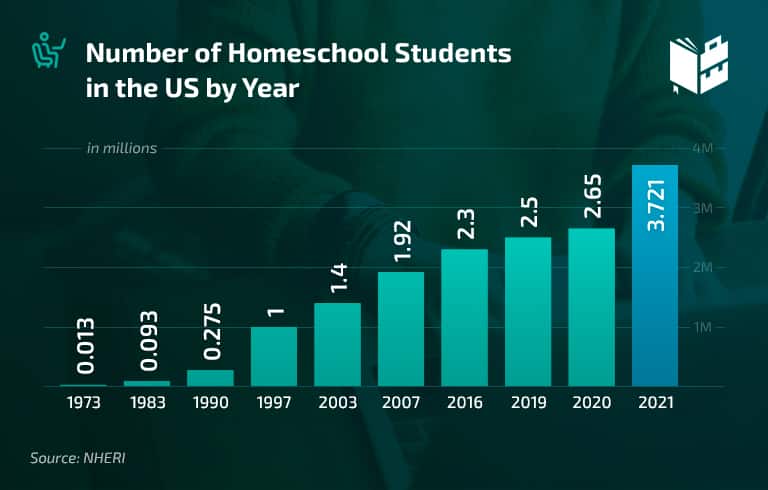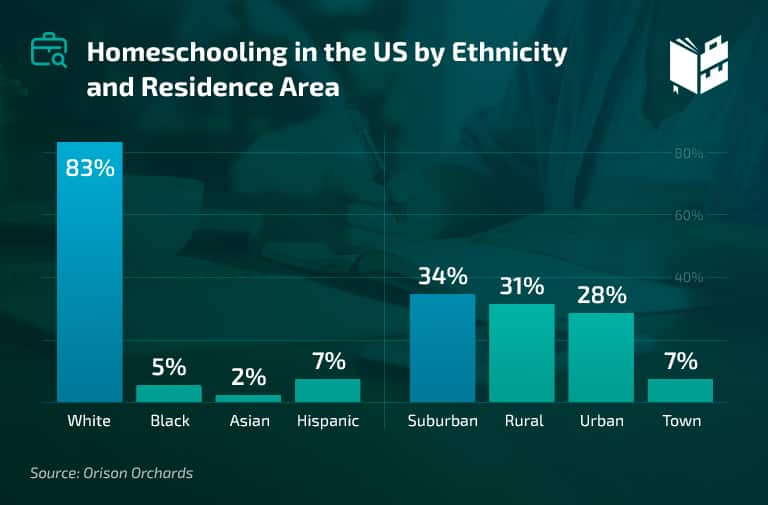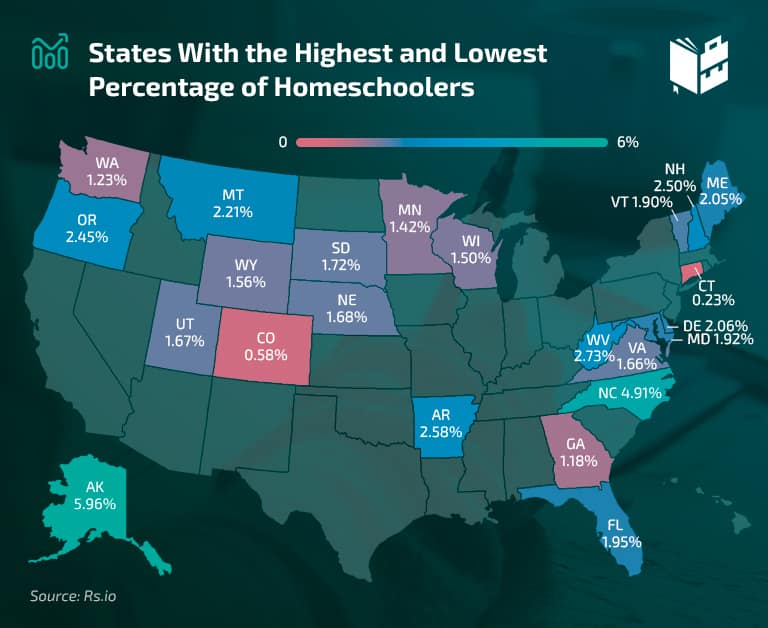Many people may doubt the quality of homeschooling. However, homeschooling statistics confirm extraordinary results. In the USA only, the number of homeschooled students is continuously increasing. Students educated at home tend to achieve better exam results than students who go to regular school. Plus, their academic achievements at a university level are impressive.
Homeschooling is approved in many countries worldwide. While it’s banned in countries such as Germany, Croatia, and Greece, it’s widespread in the USA, Canada, Australia, and New Zealand. Homeschoolers come from families with different education levels and incomes. The reasons why parents opt for educating their children at home are many. They vary from a lack of satisfaction with the regular education system to their children’s needs.
Top Homeschool Statistics You Must Know (Editor’s Choice)
- Homeschoolers comprise about 6–7% of the school-age population.
- 83% of children educated at home are white.
- Homeschoolers have 15% to 30% higher scores on achievement tests.
- There are 3.7 million homeschoolers in the USA.
- The percentage of parents homeschooling their children in 2022 is 8%.
- Home education rate increases by 7% to 15% annually.
- 80% of parents choose to educate their children at home because of safety concerns.
- Homeschooled students’ graduation rate is 66.7%.
Intriguing Homeschooling Facts and Stats
1. 3.7 million students in the USA are homeschooled.
(NHERI)
Homeschooling in the USA is a lot more popular than people may think, and the number of homeschooled children is ever-increasing. More and more parents are refusing to send their kids to school. Instead, they choose to educate them at home. The primary reasons might be dissatisfaction with the quality of teaching and safety concerns.
According to homeschool statistics, there are 3.7 million homeschoolers in the USA as of 2021. This outstanding figure shows that 6%–7% of school-age children are homeschoolers. Compared to the previous year, the stats show a growing trend — approximately 2%–8% per year.

2. 7.4% of White parents say at least one of their children were homeschooled in the 2020–2021 school year.
(NCES)
Homeschooling is becoming immensely popular among all races, but the majority of homeschooled children are white. 5.1% of Black parents claim at least one of their kids is a homeschooler, and 6.5% of Hispanic and 3.6% of Asian parents say the same, according to homeschool demographics.
It’s essential to mention that homeschooling knows no boundaries. Many parents decide to homeschool their children. Religion doesn’t play a significant role here because both atheists and believers opt for home education.
Social status is also unimportant as you can find members of all classes — low, middle, and high. Lastly, political background and education also don’t affect the decision to homeschool children, as both conservatives and liberals do so.
3. 5.7 million American children were homeschooled at some point.
(Homeschoolers of Maine)
Stats on homeschooling indicate that approximately 3.4 million adults in the USA have been homeschooled for at least one out of their K-12 school years. On average, they’ve been homeschooled for 6–8 years. If you combine these numbers with the 2.3 million homeschoolers today, you’ll get an impressive number of 5.7 million homeschooled Americans.
4. 83% of homeschooled children are white.
(Orison Orchards)
According to homeschooling statistics, a large number of white American students are homeschooled (83%). The percentage of other races is significantly smaller. Only 2% of Asian, 5% of African-American, and 7% of Hispanic students are home educated.
The demographics reveal that 34% live in suburban areas, while 31% live in rural locations; 28% are based in cities and 7% in towns.

What Is the Percentage of Homeschooled Students Who Go to College?
Contrary to what many people may think, students who are educated at home do continue their education at colleges and universities. In fact, they tend to achieve better results and higher scores on assessment tests than their peers who attended public or private schools.
5. 30% of homeschoolers’ parents have a bachelor’s degree.
(Admissionsly)
Regarding homeschoolers’ parents’ education, national homeschooling statistics indicate that homeschooled students come from families with different education levels. 15% didn’t graduate from high school, as opposed to 16% who finished secondary education or obtained a GED. 25% of parents underwent some college training, while 30% received a bachelor’s degree. Finally, 15% of the parents completed graduate or professional school.
6. Almost 2.6 million children moved to homeschooling after the COVID-19 pandemic onset.
(Bellwether Education, NCES)
Homeschooling became officially approved in all 50 states back in 1993. Six years later, the number of homeschoolers in the US grew to 850,000. According to NCES statistics, the figure reached 1.77 million in 2012.
The COVID-19 pandemic further contributed to the increase in homeschooling. In fact, almost 2.6 million children switched to this form of education in 2020.
7. Homeschoolers have 15–30 percentile points more than their peers on standardized academic achievement tests.
(NHERI)
Homeschooling data reveals that children who are educated at home have much better results on standardized achievement tests than their peers who go to regular schools. This particularly applies to students educated by parents who may or may not have formal education or a diploma and are on a broad income spectrum. Such results indicate that parents’ background has little to no impact on the quality of home education.
8. Homeschoolers obtain 72 points more (out of 1600) than the national average on the SAT.
(Orison Orchards)
With more students choosing to continue their education after graduating from high school, the competition is getting fiercer. To enroll in a desired high-quality college or university, students need to achieve impressive results.
According to homeschoolers in college statistics, students educated at home show better results on college entrance tests. More precisely, they scored 72 points more on the Scholastic Aptitude Test (SAT) than the national average. Similarly, they obtained 22.8 out of 36 points on the American College Test (ACT), compared to the national average of 21 points.
9. Students educated at home graduate from a college at a 66.7% rate.
(Orison Orchards)
Homeschoolers show considerable homeschool success rates. The University of St. Thomas conducted a study that revealed that homeschoolers graduate from a college at a nearly 10% higher rate than their peers who finished regular public high school (57.5%). The study also found that homeschoolers applied to college with an average of 26.5 composite ACT, compared to students from regular schools who had a 25 composite. Besides, homeschooled students continually earned a greater GPA compared to other students.
What Are the Reasons for Homeschooling?
Parents opt to homeschool their children for many different reasons. Some aren’t satisfied with the program and curriculum, and therefore, their kids’ results. They believe that children could have better grades if educated at home. Others are concerned about their children’s safety due to the increased bullying and violence rates at schools. Lastly, the coronavirus pandemic forced everyone to reconsider the benefits of homeschooling.
10. The homeschooling rate dropped by 1% for the 2021–2022 school year.
(HSLDA)
Around 11% of USA households were homeschooling at least one of their children in the 2020–2021 school year. Homeschooling statistics by state reveal that 7% were homeschooling at least one child, while 4% of households were homeschool-only.
Even though the research estimates for the 2021–2022 school year implied a significant drop in the number of homeschooling households, the most recent projections from a Household Pulse Survey show only a 1% decrease from last year.
11. 14,780 students received homeschooling in Nebraska in 2020.
(Nebraska Department of Education)
The coronavirus pandemic has driven parents to consider educating their children at home. The number of homeschoolers by state has increased by almost 64% across Nebraska, compared to 2019 when there were 9,450 homeschooled students. The number dropped to 10,525 in 2021, but it’s still the highest count over the years except 2020.
12. 8% of parents are homeschooling their children in 2022.
(Deloitte)
American parents take COVID-19 rather seriously. They are too concerned about risking their children’s health to let their children go to school. According to homeschooling vs. public schooling statistics, the percentage of families who homeschool their children grew from 4% in 2021 to 8% in 2022.
13. The sales of homeschooling curriculums rose by 50%.
(MPR News)
The pandemic forced schools to switch to online teaching during the lockdown. However, parents seem to be dissatisfied with the quality of online learning. Seeing no other opportunity for the upcoming school year, they decided to educate their children at home. As a result, homeschool curriculum statistics show an increase in curriculum sales by 50%.
14. 80% of parents opt for home education because of safety concerns.
(NCES)
Parents in the States are becoming more worried about their children’s safety at school, primarily because of drugs, bullying, and negative peer pressure. These safety concerns are among the greatest drivers that pushed them to educate their children at home.
15. Home education grows by 7% to 15% every year.
(Family Education)
Home education is getting more popular every year. The statistics reveal that homeschooling rates are increasing by 7%–15% every year. Many parents choose to educate their children at home due to a range of reasons. Some include the freedom to choose what they want to teach and at which pace, considering they cover all the fundamentals. Another important reason is the lack of peer pressure, competition, and bullying that may have an adverse effect on children.
16. Alaska is the leading state with 5.96% of homeschoolers.
(Rs.io)
According to homeschooling percentage by state, Alaska holds the top position, with nearly 6% of homeschooled students. North Carolina is in second place with 4.91%, followed by West Virginia, with 2.73% of homeschoolers. The figures show that parents mainly choose to teach their children at home, primarily because of safety concerns. But, some statistics tend to be a bit surprising. Colorado and Connecticut don’t seem to favor homeschooling, with 0.58% and 0.23% of homeschoolers, respectively.

Surprising Statistics Against Homeschooling
Home education may have its negative sides, one of them being the fact that homeschooling may take up too much of parents’ time. A parent-teacher needs a lot of time to plan, prepare, and participate in teaching activities. Another drawback is spending too much time with children, which some parents might find a bit difficult. Lastly, homeschooled children have fewer opportunities to socialize and participate in group activities with their peers.
17. The costs of home supplies may amount to $700–$1,800 a year.
(Time4Learning, Love To Know)
Negative homeschooling statistics reveal that educating children at home might be too costly on some occasions. It’s the homeschooling supplies that are somewhat pricey. Even if they are bought second-hand, boxed curriculums necessary for teaching kids at home may be a bit expensive. This can put extra pressure on a family budget.
Apart from extra costs, other homeschooling disadvantages may include problems regarding parents’ time management and excessive workload. Such problems are not to be neglected as they may lead to stress and burnout, which is probably one of the reasons why fewer than 1% of kids requiring special ed are homeschooled.
Luckily, there are several ways to overcome such challenges. Instead of buying, parents may borrow the curriculum material. Also, they might do internet research and find a free curriculum online. Lastly, they may get in touch with homeschooling groups and see if help is available there.
18. Homeschooling parents spend $600 on average per student.
(NHERI)
As for homeschooling USA statistics, homeschooling families in the States spend $600 per student on average every year. Taxpayers pay $15,240 per student on average in public schools every year, with capital expenditures included. Conversely, they don’t pay a single cent for students educated at home, as it’s their parents who are responsible for financing their children’s education.
19. Homeschooling saves $56 billion that the American taxpayers would have to pay for education.
(NHERI)
Statistics on homeschooling show that homeschooling allows taxpayers to save a whopping $56 billion every year. In other words, families who are into home education rely solely on their budget to educate their children. Therefore, they don’t depend on the resources that taxpayers provide. This implies that homeschooling is beneficial for the federal budget, considering that parents bear all the costs of education.
Worldwide Homeschool vs. Public School Facts
20. 21,437 children in Australia were homeschooled in 2019.
(HSLDA, Evening Report NZ)
Homeschooling is on the rise in Australia and New Zealand as well. In 2013, there were about 1,100 homeschoolers in Queensland only. That figure rose to 3,232 in 2018. According to the latest data, there were more than 20,000 homeschoolers in 2019 across the country. This translates to a 105% growth over 8 years and a 9.4% year-over-year growth rate.
While distance education isn’t a novelty in Australia, a difference should be made between distance and homeschooling. Distance education is part of the country’s educational system, and it counts as a school. Homeschooling, on the other hand, is performed by the parent.
21. The UK saw homeschooling growth of 34% in the 2020–2021 school year.
(ADCS)
Have you ever wondered how many children are homeschooled in Britain? The number of British children educated at home rose to 115,542 in 2020–2021. The most common reason responsible for the increase was concern over the COVID-19 pandemic.
According to estimates, there were 57,500 new homeschooling applications between August 2020 and September 2021, accounting for almost half of all homeschoolers in the UK.
22. There were 36,951 homeschoolers in Canada in the 2019–2020 school year.
(Fraser Institute)
According to homeschooling statistics, almost 37,000 children are home educated in Canada. Homeschooling enrollment rose to 0.6% of total enrollment in the 2019–2020 school year. The provinces with the highest percentage of homeschooled children within total enrollment are Alberta (2%), Manitoba (1.8%), and Saskatchewan (1.4%).
The Bottom Line: Advantages and Disadvantages of Homeschooling
There are about 3.7 million homeschoolers in the USA, accounting for 6–7% of the total number of schoolchildren. However, the growing number of children educated at home is continually increasing, reinforcing parents’ desire to have more control over their childrens’ education.
According to the benefits of homeschooling statistics, the advantages of home education are multifold. Some of the most significant include better scores at the standardized assessment tests such as SAT and ACT and excellent academic performance at colleges and universities.
There are a few disadvantages of homeschooling, but they are surmountable. They range from time management, limited involvement in group activities, the lack of social interaction, and too much time spent with the family. All things considered, homeschooling benefits greatly outweigh the drawbacks.